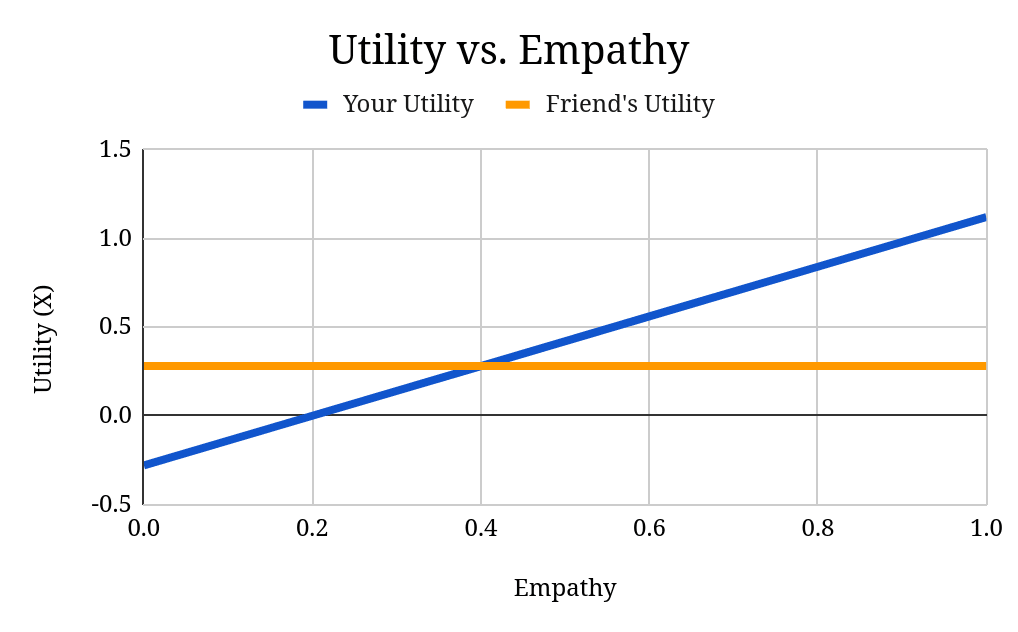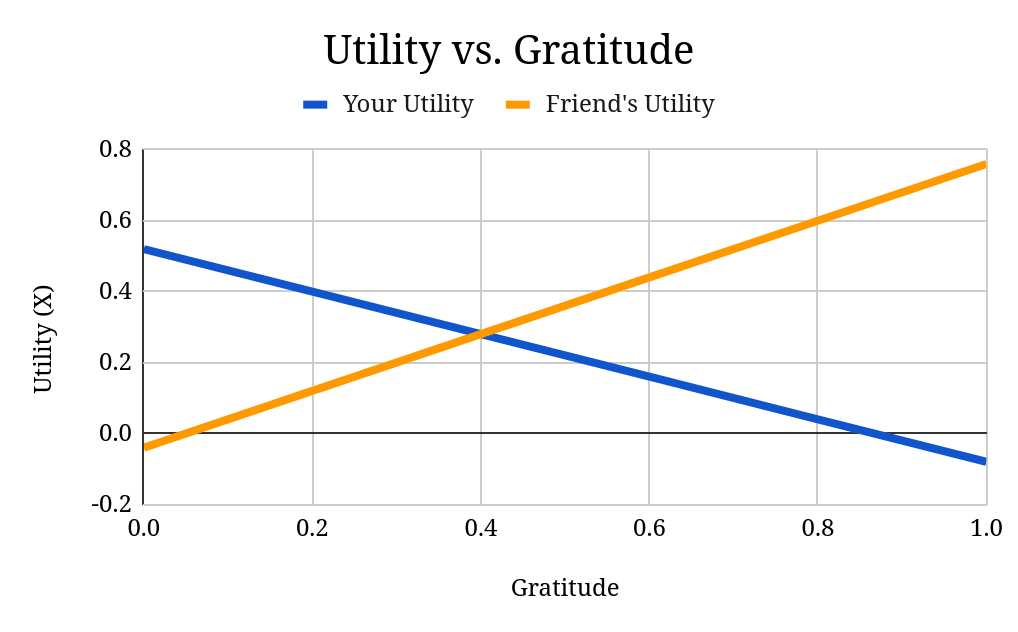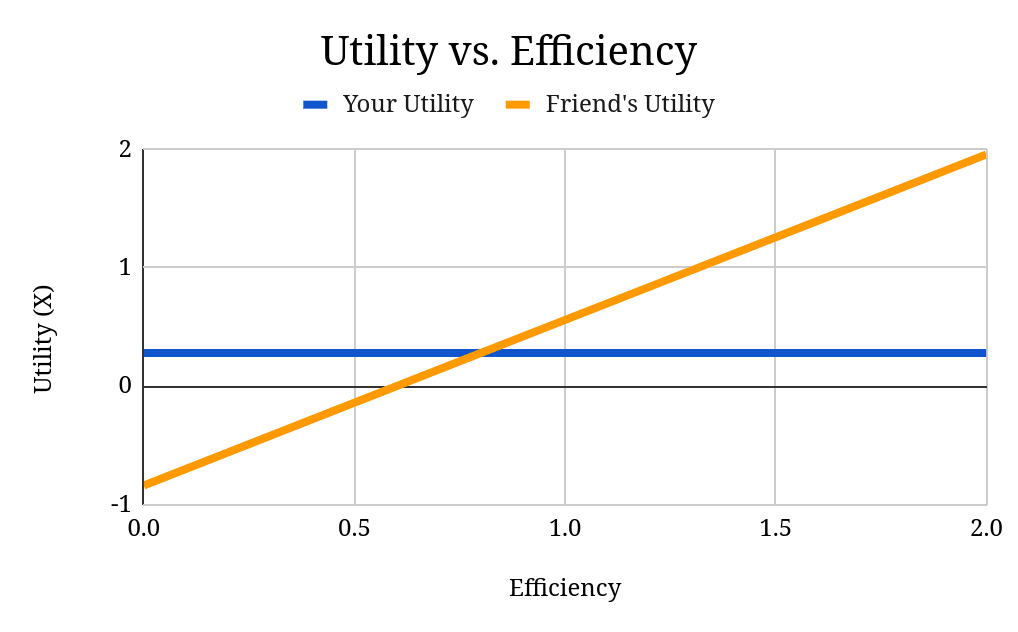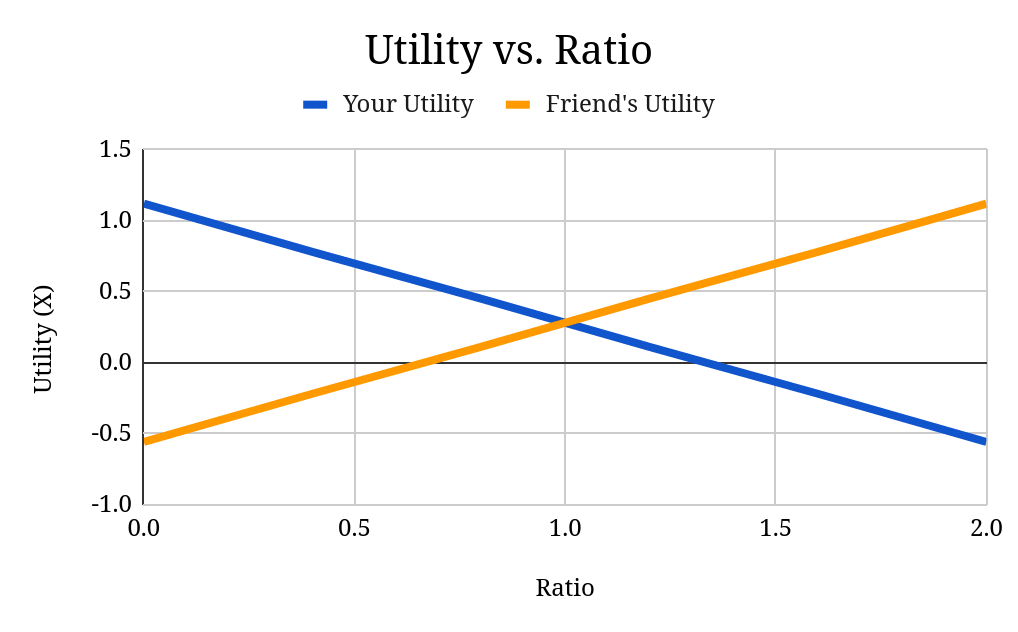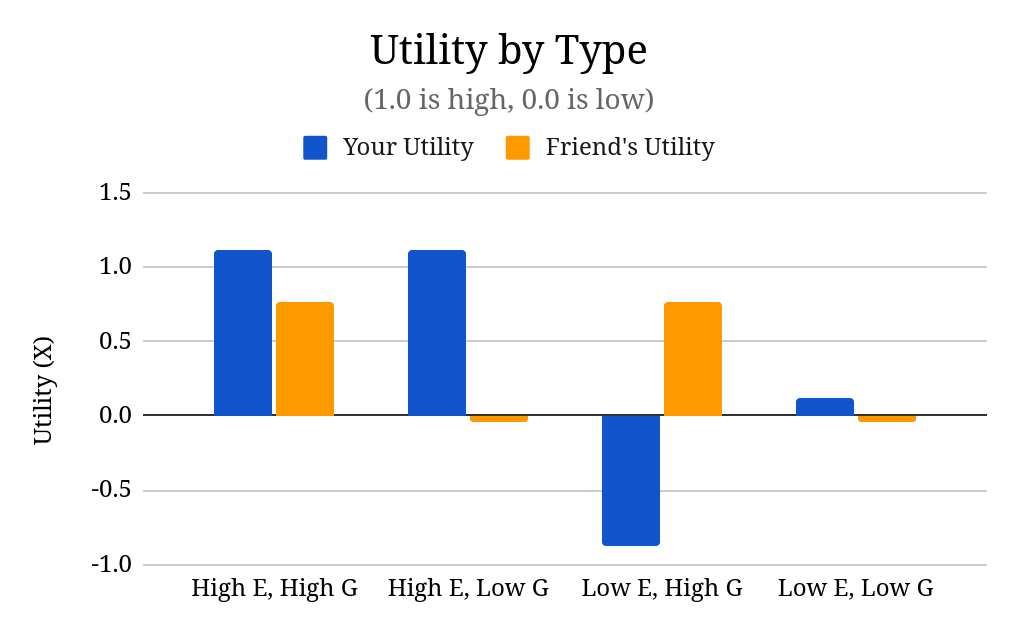Modelling Social Exchange: A Systematised Method to Judge Friendship Quality
post by Wynn Walker · 2024-08-04T18:49:30.892Z · LW · GW · 0 commentsContents
Introduction Variables The Maths Visuals The Model When can this be used? Flaws with the model Summary Calculator None No comments
Introduction
Evolution has designed humans to be empathetic to help others, and grateful to give back in a mutually beneficial transaction. Unfortunately, not all series of exchanges are fair long-term.
Whether these relationships are worth it is ordinarily up to intuition, but there are more accurate ways of reaching a conclusion. Not unlike Fermi guessing [LW · GW], this is a way of plugging multiple estimates into one equation to output an answer as to how much overall utility [? · GW] your company grants you.
Variables
These are the variables that will be used in the equation:
Empathy Level: How much utility one gains from the emotional satisfaction of giving.
- A score of 1.0[1] indicating you gain equal utility to that which you lose.
- A score of 0.0 indicating no utility gained when spent.
Gratitude Level: How much one gives back after being given.
- A score of 1.0 indicating you repay exactly the same amount of utility that they spent on you.
- A score of 0.0 indicating you do not repay any utility.
Imagine one friend is teaching another which keyboard shortcuts to use for a piece of software, or a poor friend lending money to a richer friend. In either of these situations the utility spent does not match the utility gained. The ratio of gain to loss can be summarised as the efficiency of the transaction.
(Note that if your friend spends X utility on you, and you gain <X, gratitude uses the original X value, as your brain will likely compensate).
These values will hereafter be referred to as follows:
| Metric | You | Your friend |
| Empathy Score | Y(E) | F(E) |
| Gratitude Score | Y(G) | F(G) |
| Efficiency | Y(N) | F(N) |
While every interaction is different, over enough time there is an average, in which case every favour happens in six steps:
- You spend X utility helping your friend.
- You gain Y(E)*X utility.
- Your friend gains Y(N)*X utility.
- Your friend feels gratitude and decides to repay F(G)*X utility.
- Your friend regains F(E)*F(G)*X utility.
- You gain F(N)*F(G)*X utility.
The Maths
| Change in Utility | You | Your friend |
| Utility gain (Concrete) | F(G)*F(N)*X | Y(N)*X |
| Utility gain (Empathy) | Y(E)*X | F(E)*F(G)*X |
| Utility loss | X | F(G)*X |
If you put all this together you get the following:
| Beneficial to you if | F(G)*F(N) + Y(E) - 1 > 0 |
| Beneficial to your friend if | Y(N) + F(E)*F(G) - F(G) > 0 |
Additionally, we can reverse this table to get the friend’s favour’s results:
| Beneficial to your friend if | Y(G)*Y(N) + F(E) - 1 > 0 |
| Beneficial to you if | F(N) + Y(E)*Y(G) - Y(G) > 0 |
Just because giving a favour is not beneficial to you, doesn't mean it isn’t worthwhile, as your friend is going to be supplying his own favours to you.
Let’s add one final variable R for the next table:
Out of every two[2] arbitrary units of value that are exchanged in the relationship, R is the average value given by yourself. If you're giving service 75% of the time, R=1.5, although if your deeds are half as small, R=1.2. We'll take this value and multiply it with the utility changes associated with favours for your friend, and (2-R) for favours directed at you.
This is the table shown previously, but with your friend’s favours and the rate at which it happens accounted for:
| Type of change | You | Your friend | |
| Change when favouring | Utility gain (Concrete) | R*F(N)*F(G)*X | R*Y(N)*X |
| Utility gain (Empathy) | R*Y(E)*X | R*(E)*F(G)*X | |
| Utility loss | R*X | R*F(G)*X | |
| Change when favoured | Utility gain (Concrete) | (2-R)*F(N)*X | (2-R)*Y(N)*Y(G)*X |
| Utility gain (Empathy) | (2-R)*Y(E)*Y(G)*X | (2-R)*F(E)*X | |
| Utility loss | (2-R)*Y(G)*X | (2-R)*X |
| Benefits you if | R*(F(G)*F(N) + Y(E)) + (2-R)*(F(N) + Y(E)*Y(G)) - R - (2-R)*Y(G) > 0 |
| Benefits your friend if | (2-R)*(Y(N)*Y(G) + F(E)) + R*(Y(N) + F(E)*F(G)) - (2-R) - R*F(G) > 0 |
If you want to try this out, I made a calculator, you can find it at the end of the post [? · GW].
Visuals
Let’s model how changing different traits affect the gain of both parties. This is a rather baseless estimation, but for a simple visualisation it doesn’t matter. I’ll assume both people are “average” with E = 0.4, G = 0.4, N = 0.8[3] and R = 1.0. These four graphs depict how utility changes when certain traits are altered.[4]
As you can see, gratitude harms you while helping the other, but empathy only helps oneself.
Efficiency is the mirror of empathy, while ratio does what you’d expect.
The Model
From these results, we can imagine four types of people who exist and their respective relationship quality:
| Type of person | Pursues friends? | Can keep them? | Satisfied? |
| High Empathy, High Gratitude | Yes | Yes | Yes |
| High Empathy, Low Gratitude | Yes | No | No |
| Low Empathy, High Gratitude | No | Yes | Yes |
| Low Empathy, Low Gratitude | Neutral | No | Neutral |
From this one could imagine extraverts being in the first category, neurotic “introverts” (failed extraverts) in the second[5], and the last two as introverts.
As failed extraverts are often erroneously classified as introverts, additionally those with low gratitude are unhappier, it would follow that if this model were accurate “introverts” are on average unhappier than extraverts, which is true.
This model suggests that most people who want friends but can’t make them are lacking in gratitude, which is true. Of course, none of this is empirical by any means, but helps illustrate the model was not plucked out of thin air. In order to draw more conclusions about its validity, I would need data on how an average person ranks, standard deviations, so on and so forth, until then this is purely theoretical.
When can this be used?
I intend for this equation to be put into action during friendships spanning years, any less and there wouldn't be enough evidence to determine their characteristics.
Flaws with the model
- The closer you are to a person, the more gratitude and empathy you may feel. Relationships tend to change over time.
- Favours may not be consistent enough to model, oftentimes a single favour, say a job offer, overshadows everything else, making the relationship worthwhile even if its value < 0.
- It's not designed for relationships where favours are habitual or obligated, such as a professor and his student.
- You or your friend may not be utilitarians.
Summary
Simply take a guess at each value, and plug them into:
- If the value is less than zero, you should not encourage favours in the friendship.
- If the value is lower compared to other relationships, consider the opportunity cost.
- If the value is high, encourage favours.
Your friend is also doing the same thing, consciously or not, so check to be sure they don’t terminate the relationship.
Calculator
As this is my first post, any feedback is highly encouraged.
- ^
Studies [LW · GW] show that empathy is likely the result of similarity between experience of the self and experience of others, in which case they can only be so identical as to create a 1 to 1 ratio of give to gain. Any time you feel better after doing something nice, it’s because you’re in a position where you expend less utility than the other person receives (according to the theory, anyway).
- ^
I could simplify things by making it 0.0 to 1.0, but I’d prefer to think in terms of full favours rather than half favours.
- ^
In my experience, transactions with high efficiency tend to be small (picking up a pen that was dropped near you) and large transactions tend to be inefficient (planning a birthday party), thus I use an N value < 1.0.
- ^
This doesn’t cover nearly all scenarios, but I’m sure you can use your imagination for the rest.
- ^
I am calling this category neurotic because they are the only ones which are predicted to have sour relationships, something that correlates heavily with the trait.
0 comments
Comments sorted by top scores.
